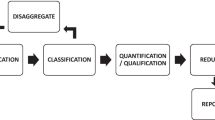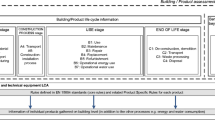Abstract
Purpose
Two obstacles that impede wider use of life cycle assessment (LCA) are its time- and data-intensiveness and the credibility surrounding its results—challenges that grow with the complexity of the product being analyzed. To guide the critical early-design stages of a complicated product like a building, it is important to be able to rapidly estimate environmental impacts with limited information, quantify the resulting uncertainty, and identify critical parameters where more detail is needed.
Methods
The authors have developed the Building Attribute to Impact Algorithm (BAIA) to demonstrate the use of streamlined (not scope-limiting), probabilistic LCA for guiding the design of a building from early stages of the design process when many aspects of the design are unknown or undecided. Early-design uncertainty is accommodated through under-specification—characterizing the design using the available level of detail—and capturing the resulting variability in predicted impacts through Monte Carlo simulations. Probabilistic triage with sensitivity analyses identifies which uncertain attributes should be specified further to increase the precision of the results. The speed of the analyses allows for sequentially refining key attributes and re-running the analyses until the predicted impacts are precise enough to inform decision-making, such as choosing a preferable design alternative.
Results and discussion
Twelve design variants for a hypothetical single-family residential building are analyzed. As information is sequentially added to each variant, the significance of the difference in performance between each variant pair is calculated to determine when enough information has been added to resolve the designs (identify which design is preferable) with high confidence. At the sixth step in the analysis, all variant pairs whose mean impacts differ by at least 4% are resolvable with 90% confidence, even though only six attributes are specified and dozens of attributes remain under-specified. Furthermore, the comparative results for each variant pair are validated against a set of conventional LCA results, showing that BAIA identifies the correct preferable design among each resolvable pair at this step.
Conclusions
Iterative specification guided by probabilistic triage can help identify promising early-design alternatives even when details are only provided for key attributes. The analysis of hypothetical design variants demonstrates that BAIA is both efficient (arrives at statistically defensible conclusions from design variant comparisons based on few pieces of information) and effective (identifies the same preferable design variants as conventional LCAs).




Similar content being viewed by others
Abbreviations
- AAM:
-
Attribute to activity model
- BAIA:
-
Building Attribute to Impact Algorithm
- BEopt:
-
Building Energy Optimization, NREL software
- BIM:
-
Building information modeling
- BOA:
-
Bill of activities
- CI:
-
Comparison indicator
- CV:
-
Coefficient of variation
- FS:
-
Fully specified
- GWP:
-
Global warming potential
- HVAC:
-
Heating, ventilation, and air conditioning
- IE:
-
Athena Impact Estimator
- JMP:
-
Statistical software from SAS
- LCA:
-
Life cycle assessment
- MC:
-
Monte Carlo
- NREL:
-
National Renewable Energy Laboratory
- ESM:
-
Electronic Supplementary Material
References
Aktas CB, Bilec MM (2012) Impact of lifetime on US residential building LCA results. Int J Life Cycle Assess 17(3):337–349. https://doi.org/10.1007/s11367-011-0363-x
Al Gharably M, DeCarolis JF, Ranjithan SR (2016) An enhanced linear regression-based building energy model (LRBEM plus ) for early design. J Build Perform Simu 9(2):115–133. https://doi.org/10.1080/19401493.2015.1004108
Asadi S, Amiri SS, Mottahedi M (2014) On the development of multi-linear regression analysis to assess energy consumption in the early stages of building design. Energ Buildings. https://doi.org/10.1016/j.enbuild.2014.07.096
Athena Sustainable Materials Institute (2015) Impact Estimator for Buildings v5.1.0102
Basbagill J, Flager F, Lepech M, Fischer M (2013) Application of life-cycle assessment to early stage building design for reduced embodied environmental impacts. Build Environ 60:81–92. https://doi.org/10.1016/j.buildenv.2012.11.009
Basbagill JP, Flager FL, Lepech M (2014) A multi-objective feedback approach for evaluating sequential conceptual building design decisions. Automat Constr 45:136–150. https://doi.org/10.1016/j.autcon.2014.04.015
Ecoinvent Centre - Swiss Centre for Life Cycle Inventories (2007) Ecoinvent database. Duebendorf
European Committee for Standardization (2011) EN 15978:2011 Sustainability of construction works. Assessment of environmental performance of buildings. Calculation method
Gervásio H, Santos P, Martins R, Simões da Silva L (2014) A macro-component approach for the assessment of building sustainability in early stages of design. Build Environ 73:256–270. https://doi.org/10.1016/j.buildenv.2013.12.015
Graedel TE (1998) Streamlined life-cycle assessment. Prentice Hall, Upper Saddle River, NJ
Graedel TE, Allenby BR, Comrie PR (1995) Matrix approaches to abridged life cycle assessment. Environ Sci Technol 29:134A
Granadeiro V, Duarte JP, Correia JR, Leal VMS (2013) Building envelope shape design in early stages of the design process: integrating architectural design systems and energy simulation. Automat Constr 32:196–209. https://doi.org/10.1016/j.autcon.2012.12.003
Gregory JR, Noshadravan A, Olivetti EA, Kirchain RE (2016) A methodology for robust comparative life cycle assessments incorporating uncertainty. Environ Sci Technol 50(12):6397–6405. https://doi.org/10.1021/acs.est.5b04969
Heeren N, Mutel CL, Steubing B, Ostermeyer Y, Wallbaum H, Hellweg S (2015) Environmental impact of buildings—what matters? Environ Sci Technol 49(16):9832–9841. https://doi.org/10.1021/acs.est.5b01735
Heijungs R, Kleijn R (2001) Numerical approaches towards life cycle interpretation five examples. Int J Life Cycle Assess 6(3):141–148. https://doi.org/10.1007/BF02978732
Hester J, Gregory J, Kirchain R (2017) Sequential early-design guidance for residential single-family buildings using a probabilistic metamodel of energy consumption. Energ Build 134:202–211. https://doi.org/10.1016/j.enbuild.2016.10.047
Hollberg A, Ruth J (2016) LCA in architectural design—a parametric approach. Int J Life Cycle Assess 21(7):943–960. https://doi.org/10.1007/s11367-016-1065-1
Huijbregts MA, Gilijamse W, Ragas AM, Reijnders L (2003) Evaluating uncertainty in environmental life-cycle assessment. A case study comparing two insulation options for a Dutch one-family dwelling. Environ Sci Technol 37(11):2600–2608. https://doi.org/10.1021/es020971+
Hunt RG, Boguski TK, Weitz K, Sharma A (1998) Case studies examining LCA streamlining techniques. Int J Life Cycle Assess 3(1):36–42. https://doi.org/10.1007/BF02978450
Hygh JS, DeCarolis JF, Hill DB, Ranjithan SR (2012) Multivariate regression as an energy assessment tool in early building design. Build Environ 57:165–175. https://doi.org/10.1016/j.buildenv.2012.04.021
Ikonen T, Tulkki V (2014) The importance of input interactions in the uncertainty and sensitivity analysis of nuclear fuel behavior. Nucl Eng Des 275:229–241. https://doi.org/10.1016/j.nucengdes.2014.05.015
International Association of Certified Home Inspectors (2016) Standard estimated life expectancy chart for homes. https://www.nachi.org/life-expectancy.htm. 2016
Kellenberger D, Althaus H-J (2009) Relevance of simplifications in LCA of building components. Build Environ 44(4):818–825. https://doi.org/10.1016/j.buildenv.2008.06.002
Konis K, Gamas A, Kensek K (2016) Passive performance and building form: an optimization framework for early-stage design support. Sol Energy 125:161–179. https://doi.org/10.1016/j.solener.2015.12.020
Kuo T-C, Smith S, Smith GC, Huang SH (2016) A predictive product attribute driven eco-design process using depth-first search. J Clean Prod 112, Part 4:3201–3210
Malmqvist T, Glaumann M, Scarpellini S, Zabalza I, Aranda A, Llera E, Díaz S (2011) Life cycle assessment in buildings: the ENSLIC simplified method and guidelines. Energy 36(4):1900–1907. https://doi.org/10.1016/j.energy.2010.03.026
Marsh R (2016) LCA profiles for building components: strategies for the early design process. Build Res Inf 44(4):358–375. https://doi.org/10.1080/09613218.2016.1102013
Mueller KG, Lampérth MU, Kimura F (2004) Parameterised inventories for life cycle assessment. Int J Life Cycle Assess 9(4):227–235. https://doi.org/10.1007/BF02978598
National Association of Home Builders, Bank of America Home Equity (2007) Study of life expectancy of home components
National Renewable Energy Laboratory (2016) BEopt 2.6. https://beopt.nrel.gov/home
Nielsen TR (2005) Simple tool to evaluate energy demand and indoor environment in the early stages of building design. Sol Energy 78(1):73–83. https://doi.org/10.1016/j.solener.2004.06.016
National Renewable Energy Laboratory (2013) U.S. life cycle inventory database. http://www.nrel.gov/lci/Accessed Feb 2014
Oh MS, Na S (2017) Building information modelling (BIM) based CO2 emissions assessment in the early design stage. Int J Civ Eng Technol 8:1411–1425
Olinzock MA, Landis AE, Saunders CL, Collinge WO, Jones AK, Schaefer LA, Bilec MM (2015) Life cycle assessment use in the North American building community: summary of findings from a 2011/2012 survey. Int J Life Cycle Assess 20(3):318–331. https://doi.org/10.1007/s11367-014-0834-y
Olivetti E, Patanavanich S, Kirchain R (2013) Exploring the viability of probabilistic under-specification to streamline life cycle assessment. Environ Sci Technol 47(10):5208–5216. https://doi.org/10.1021/es3042934
Oracle (2014) Crystal Ball Release 11.1.2.4.000 (32-bit). http://www.oracle.com/us/products/applications/crystalball/overview/index.html
Østergård T, Jensen RL, Maagaard SE (2016) Building simulations supporting decision making in early design—a review. Renew Sust Energ Rev 61:187–201. https://doi.org/10.1016/j.rser.2016.03.045
Østergård T, Jensen RL, Maagaard SE (2017) Early building design: informed decision-making by exploring multidimensional design space using sensitivity analysis. ENB Energy Buildings 142:8–22. https://doi.org/10.1016/j.enbuild.2017.02.059
Ramesh T, Prakash R, Shukla KK (2012) Life cycle approach in evaluating energy performance of residential buildings in Indian context. Energ Building 54:259–265
Reis L (2013) An exploration of materials taxonomies to support streamlined life cycle assessment. Massachusetts Institute of Technology. http://worldcat.org. http://hdl.handle.net/1721.1/85797
Rezaee R, Brown J, Augenbroe G, Kim J (2015) Assessment of uncertainty and confidence in building design exploration. Artificial Intelligence for Engineering Design, Analysis and Manufacturing 29(04):429–441. https://doi.org/10.1017/S0890060415000426
Romani Z, Draoui A, Allard F (2015) Metamodeling the heating and cooling energy needs and simultaneous building envelope optimization for low energy building design in Morocco. Energ Building 102:139–148
Royal Institution of Chartered Surveyors (2006) Life expectancy of building components: surveyors’ experiences of buildings in use: a practical guide. Building Cost Information Service Ltd., London
Samuelson H, Claussnitzer S, Goyal A, Chen Y, Romo-Castillo A (2016) Parametric energy simulation in early design: high-rise residential buildings in urban contexts. Build Environ 101:19–31. https://doi.org/10.1016/j.buildenv.2016.02.018
SAS Institute Inc. (2013) JMP Pro 11.2.0
Saunders CL, Landis AE, Mecca LP, Jones AK, Schaefer LA, Bilec MM (2013) Analyzing the practice of life cycle assessment: focus on the building sector. J Ind Ecol 17:777–788
Seo S, Tucker S, Newton P (2007) Automated material selection and environmental assessment in the context of 3D building modelling. J Green Build 2(2):51–61. https://doi.org/10.3992/jgb.2.2.51
Soust-Verdaguer B, Llatas C, Garcia-Martinez A (2017) Critical review of bim-based LCA method to buildings. Energy and Buildings 136:110–120. https://doi.org/10.1016/j.enbuild.2016.12.009
Soust-Verdaguer B, Llatas C, García-Martínez A (2016) Simplification in life cycle assessment of single-family houses: a review of recent developments. Build Environ 103:215–227. https://doi.org/10.1016/j.buildenv.2016.04.014
Srivastav A, Tewari A, Dong B (2013) Baseline building energy modeling and localized uncertainty quantification using Gaussian mixture models. Energy and Buildings 65:438–447. https://doi.org/10.1016/j.enbuild.2013.05.037
Tecchio P, Gregory J, Ghattas R, Kirchain R (2018) Structured under-specification of life cycle impact assessment data for building assemblies. J Ind Ecol. https://doi.org/10.1111/jiec.12746
Tecchio P, Gregory J, Olivetti E, Ghattas R, Kirchain R (2017) Streamlining the life cycle assessment of buildings by structured under-specification and probabilistic triage. J Ind Ecol. https://doi.org/10.1111/jiec.12731
The American Institute of Architects (2012) An architect’s guide to integrating energy modeling in the design process. http://www.aia.org/practicing/AIAB097932
Thinkstep (2013) GaBi Software Professional Database. http://www.gabi-software.com/databases/professional/
U.S. Department of Energy (2014) EnergyPlus:8.1.0 http://apps1.eere.energy.gov/buildings/energyplus/
U.S. Environmental Protection Agency (2010) Emissions & Generation Resource Integrated Database (eGRID)
Wang W, Zmeureanu R, Rivard H (2005) Applying multi-objective genetic algorithms in green building design optimization. Build Environ 40(11):1512–1525. https://doi.org/10.1016/j.buildenv.2004.11.017
Acknowledgements
This research was supported by the Concrete Sustainability Hub at MIT, with sponsorship provided by the Portland Cement Association and the Ready Mixed Concrete Research & Education Foundation. Thanks also to Paolo Tecchio and Carla Rodrigues for their feedback and assistance in conducting this research.
Author information
Authors and Affiliations
Corresponding author
Additional information
Responsible editor: Holger Wallbaum
Electronic Supplementary Material
ESM 1
(DOCX 310 kb)
BAIA paper SI.docx: Formulas for assembly area calculations, details on construction and performance of regression model for energy consumption, details on under-specification method and hierarchies, design variants used in case study, sequence of design decisions made in case study, sample breakdown of embodied impacts, and summary of agreement between BAIA and conventional LCA at each step of sequential design.
ESM 2
(XLSX 112 kb)
AAM-E regression coefficients.xlsx: Coefficients for stepwise regression models used in estimating building energy consumption.
Rights and permissions
About this article
Cite this article
Hester, J., Miller, T.R., Gregory, J. et al. Actionable insights with less data: guiding early building design decisions with streamlined probabilistic life cycle assessment. Int J Life Cycle Assess 23, 1903–1915 (2018). https://doi.org/10.1007/s11367-017-1431-7
Received:
Accepted:
Published:
Issue Date:
DOI: https://doi.org/10.1007/s11367-017-1431-7




